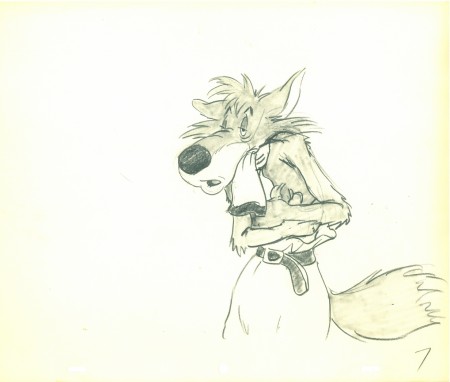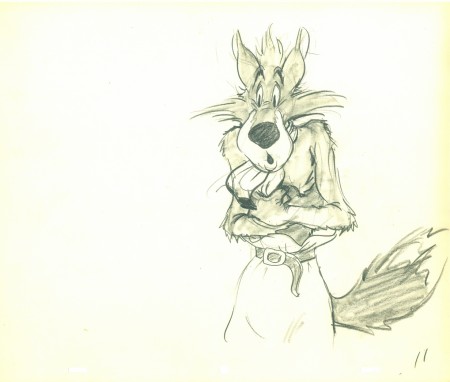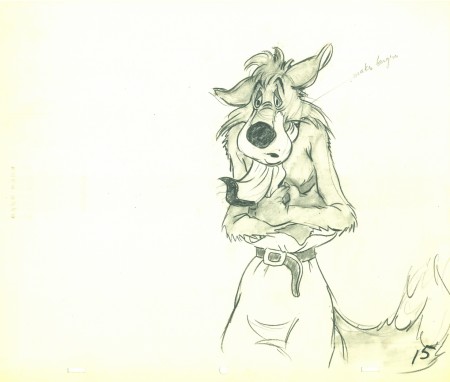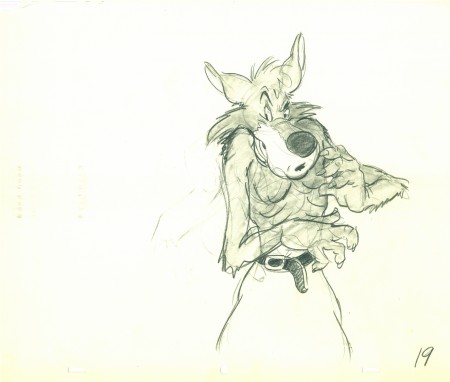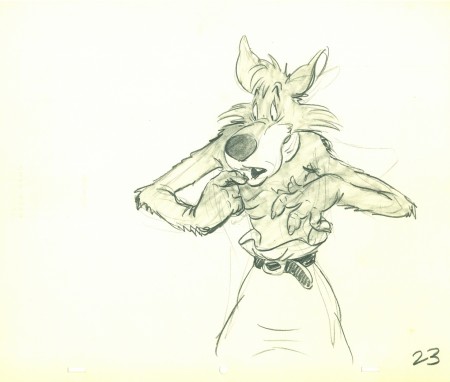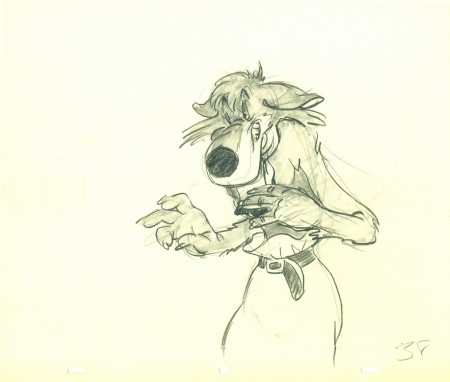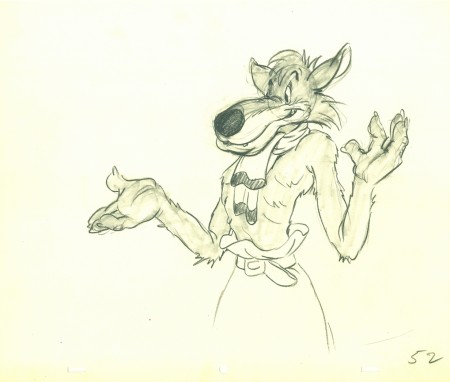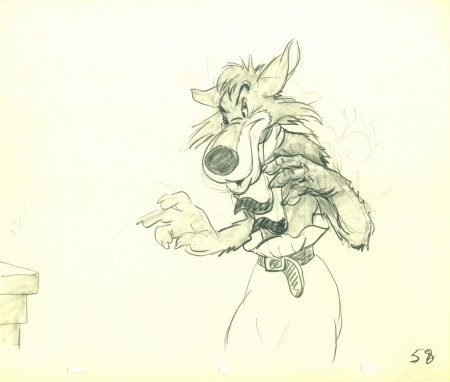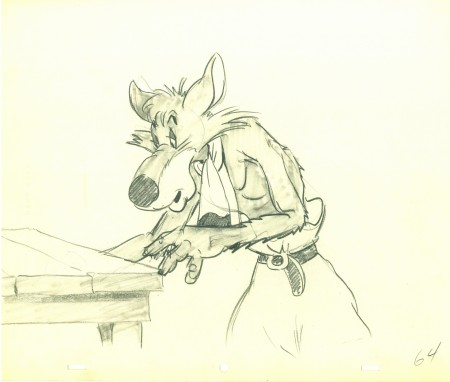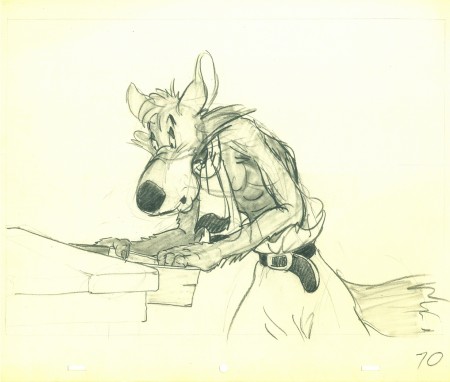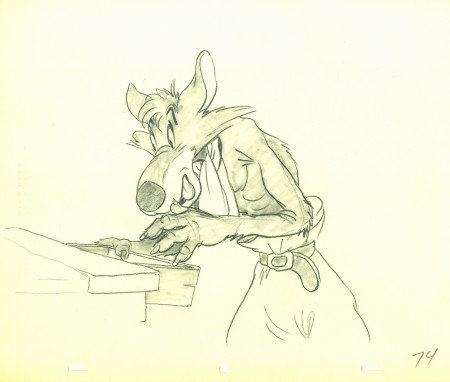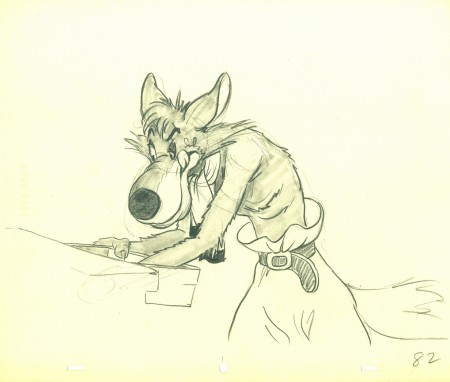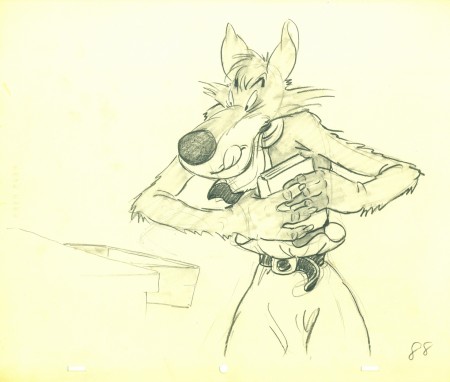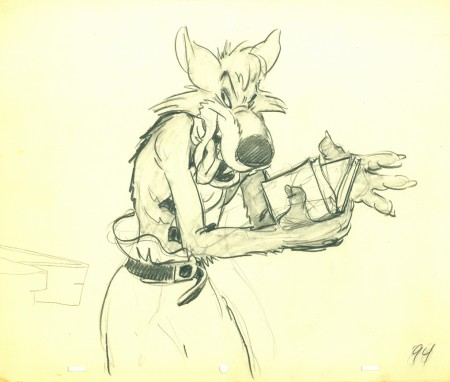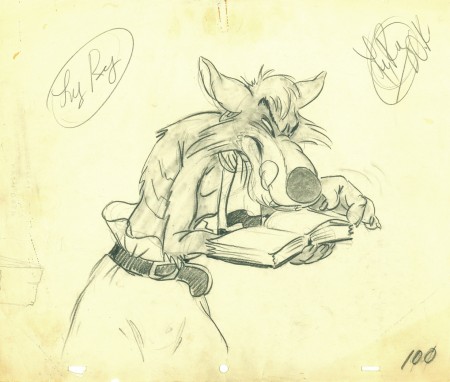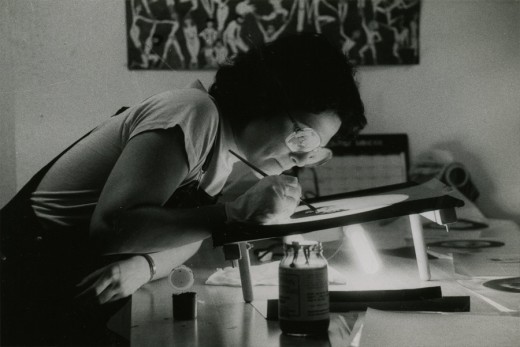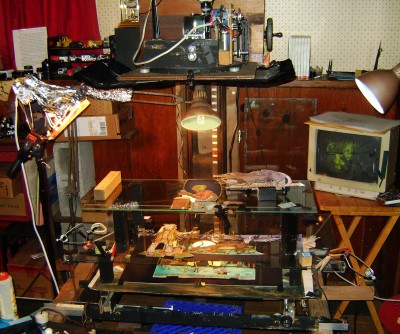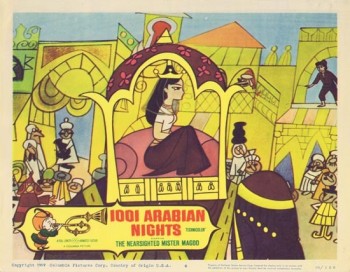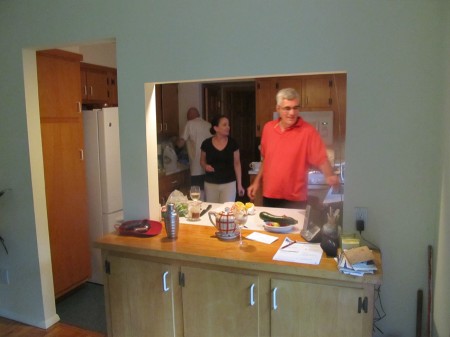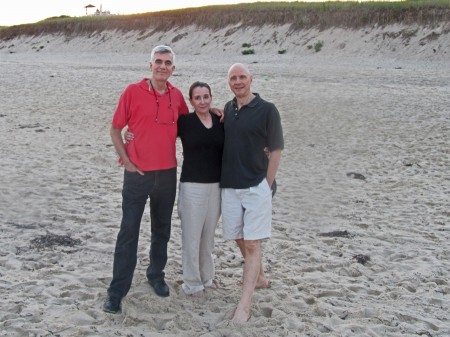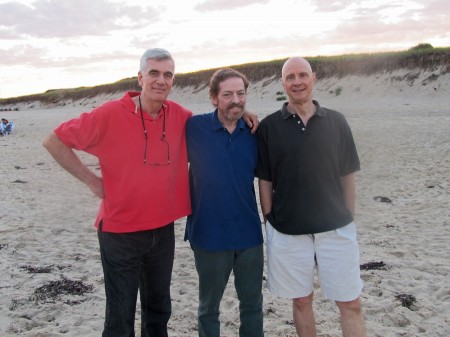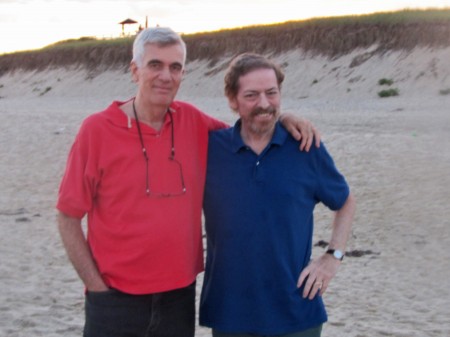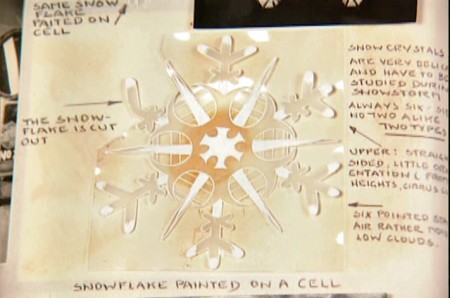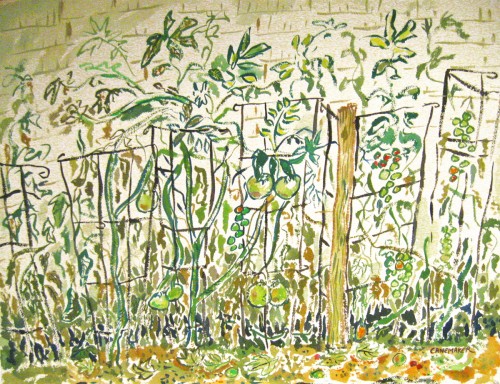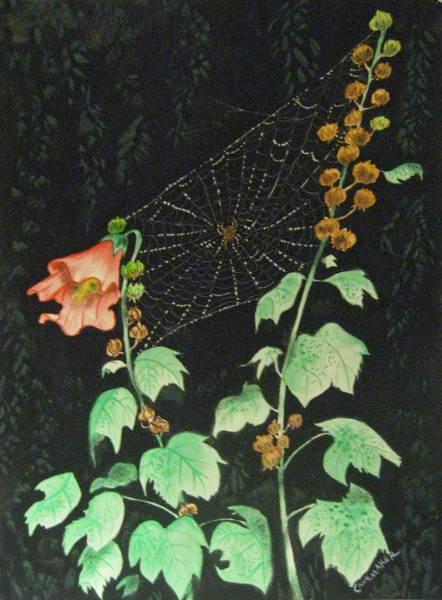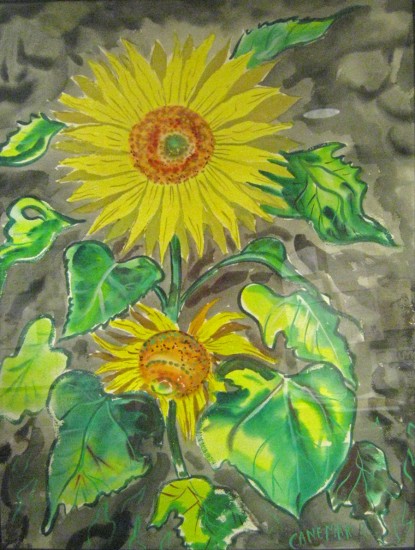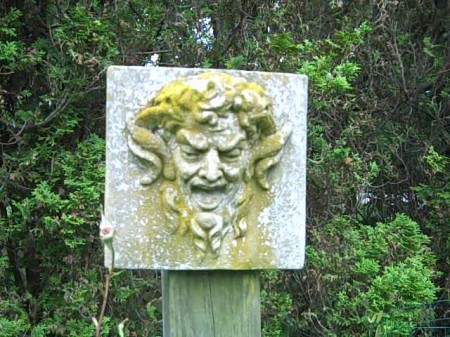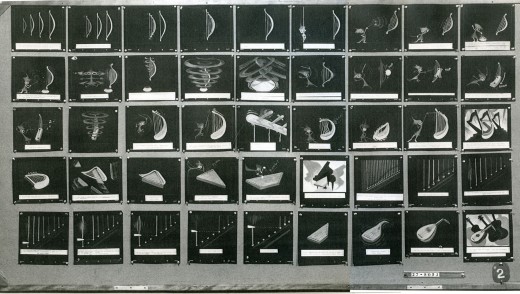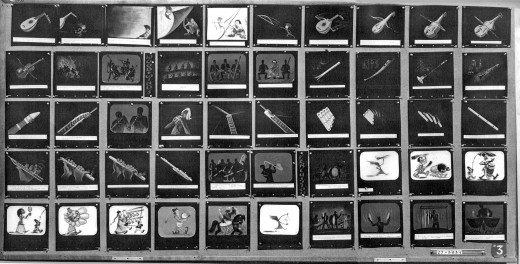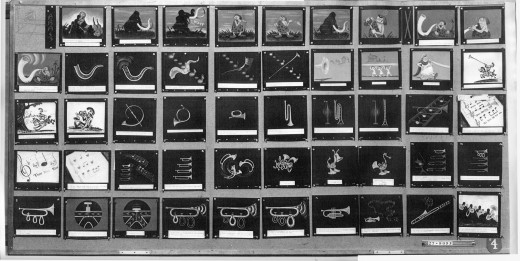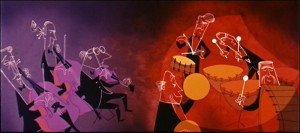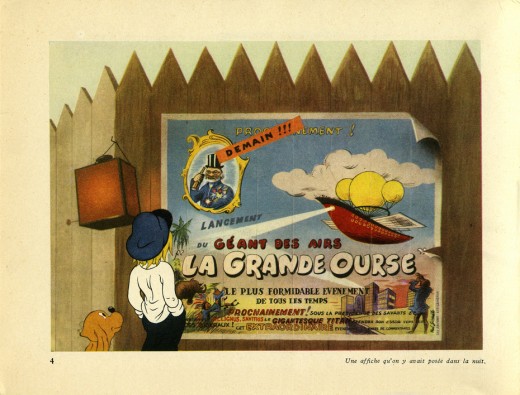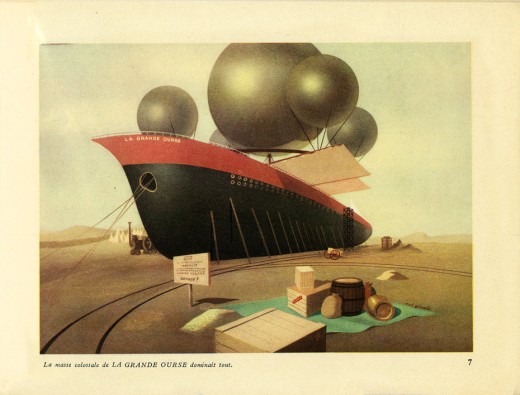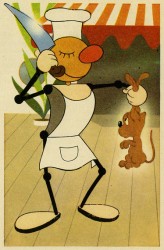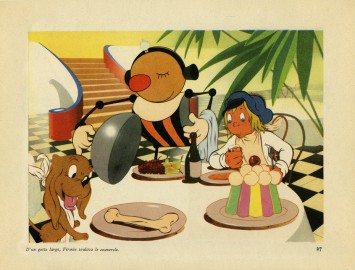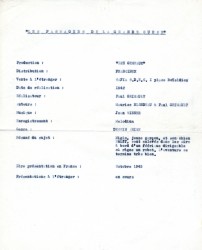Category ArchiveJohn Canemaker
Action Analysis &Animation &Animation Artifacts &John Canemaker &Tytla 16 Apr 2013 05:12 am
Tytla’s Hungry Wolf – recap
- With all the recent thought and posts on Bill Tytla, I couldn’t resist revisiting this artwork from the Harman-Ising short, The Hungry Wolf. So here it is.
 We’ve seen that Tytla veered his animation style completely toward the “Method” and there is no doubt that he carried that with him even after he left the Disney studio. Unfortunately, he went to the lowest of the low and couldn’t survive any longer as an animator. He turned to direction and had to adapt his use of Stanislavsky to his directing technique.
We’ve seen that Tytla veered his animation style completely toward the “Method” and there is no doubt that he carried that with him even after he left the Disney studio. Unfortunately, he went to the lowest of the low and couldn’t survive any longer as an animator. He turned to direction and had to adapt his use of Stanislavsky to his directing technique.
Unfortunately, the “actors” he was given weren’t up to the task. Those “actors” were the least of the animation industry, those who had learned a lot of bad techniques, ways of cheating and a lack of a deep interest in bringing the souls of his characters to life.
I was surprised to learn that Tytla had worked at a studio that was a bit better than Terrytoons or Paramount right after he’d left the haven of Disney. John Canemaker loaned me a cache of drawings for a Hugh Harman film, The Hungry Wolf, made in 1940 at MGM. It’s not a very good film; the drawings are signed by Tytla, but they have no ladder indication for an Assistant to do the inbetweens. Most oddly, the wolves are shaded in by Tytla. Also take note of the table being animated into place. Are these animation drawings? Is it LayOut posing to give to someone else to animate? And greatest of all, what is Tytla doing at MGM?
Since this would have been completed in early 1942, I can only assume that it was during the strike at Disney that Tytla did some work for Harman in mid 1941. Most probably he was acting as an Animation Director and NOT animating the scene. He worked under Harman, who got credit for directing.
There’s no attempt at distorting or stressing the drawings in any way. I assume the character wasn’t designed by Tytla. It’s similar to a character design that was used in other Harman films.
Here are all the drawings given me by John.
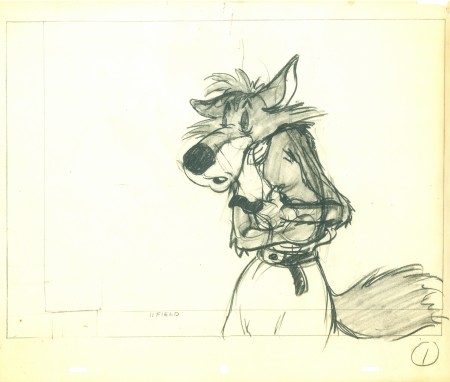 1
________________________
1
________________________.
The following is a QT of the entire scene with all the drawings included.
Since I didn’t have exposure sheets, I calculated everything on ones
(which seems to reflect the timing in the final film) and left however many drawings to the assistant and inbetweener.
Many thanks to John Canemaker for the loan of the drawings. It was great just touching them.
Animation &John Canemaker &SpornFilms 09 Dec 2012 06:04 am
WOTY recap
- Back in Jan 2007, I posted these photos from the animation production of Woman of the Year. I recently was talking about choreography, and I thought that there was one whole style of choreography wrapped up in the work of Tony Charmoli. It made me want to look back on the work I did with him, and I think these pictures are interesting enough that they’re worth revisiting. So here, again, is that post:
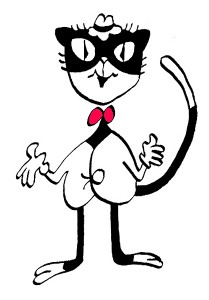 – To recap:
– To recap:
Woman of the Year was a project that came to me in the very start of my studio’s life – 1981.
Tony Walton, the enormously talented and fine designer, had gone to Richard Williams in search of a potential animator for WOTY (as we got to call the name of the show.) Dick recommended me. But before doing WOTY, there were some title segments needed for Prince of the City, a Sidney Lumet film. (I discussed that film in this post.)
Tony Walton designed the character, Katz, which would be the alter-ego of the show’s cartoonist hero, played by Harry Guardino. Through Katz, we’d learn about the problems of a relationship with a media star, played by Lauren Bacall.
It turned out to be a very intense production. Three minutes of animation turned into twelve as each segment was more successful than the last.
______________________________________________(All images enlarge by clicking.)
There was no time for pencil tests. I had to run
to Boston weekly, where the show was in try-outs, to project different segments; 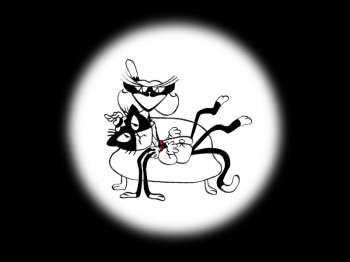 these went into the show that night – usually Wednesdays. I’d rush to the lab to get the dailies, speed to the editor, Sy Fried, to synch them up to a click track that was pre-recorded, then race to the airport to fly to the show for my first screening. Any animation blips would have to be corrected on Thursdays.
these went into the show that night – usually Wednesdays. I’d rush to the lab to get the dailies, speed to the editor, Sy Fried, to synch them up to a click track that was pre-recorded, then race to the airport to fly to the show for my first screening. Any animation blips would have to be corrected on Thursdays.
There was a small crew working out of a tiny east 32nd Street apartment. This was Dick Williams’ apartment in NY. He was rarely here, and when he did stay in NY, he didn’t stay at the apartment. He asked me to use it as my studio and to make sure the rent was paid on time and the mail was collected. Since we had to work crazy hours, it was a surprise one Saturday morning to find that I’d awakened elderly Jazz great, Max Kaminsky, who Dick had also loaned the apartment. Embarrassed, I ultimately moved to a larger studio – my own – shortly thereafter.
Here are a couple of photos of some of us working:
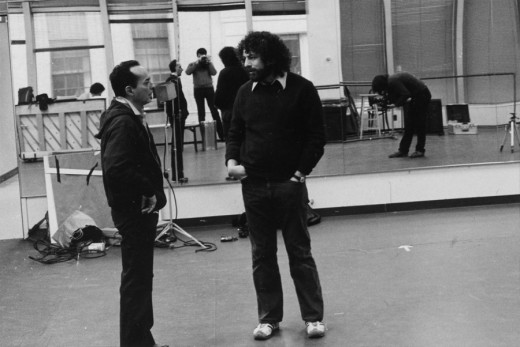
Tony Charmoli was the show’s choreographer. He worked with me in plotting out the big dance number – a duet between Harry Guardino and our cartoon character. I think this is the only time on Broadway that a cartoon character spoke and sang with a live actor on stage. John Canemaker is taking this photograph and Phillip Schopper is setting up the 16mm camera.
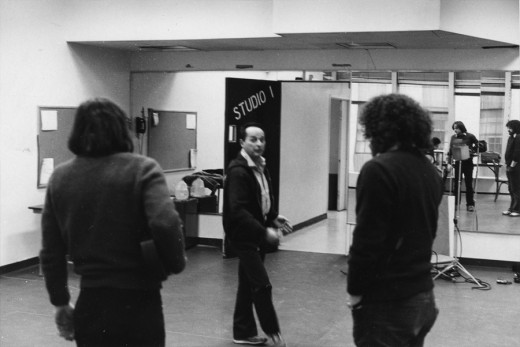
Here Tony Charmoli shows us how to do a dance step. Phillip Schopper, who is filming Tony, figures out how to set up his camera. We used Tony’s dancing as reference, but our animation moves were too broad for anyone to have thought they might have been rotoscoped.
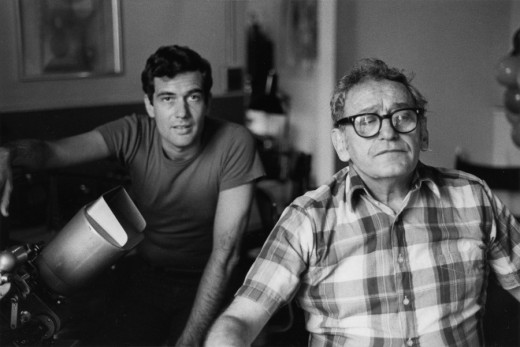
John Canemaker is working with Sy Fried, our editor. John did principal animation with me on the big number in the big ke segment. Here they’re working with the click track and the live footage of Tony Charmoli to plot out the moves.
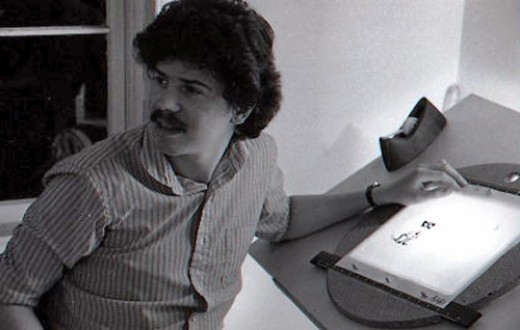
Steve Parton supervised the ink and paint. To get the sharpest lines, we inked on cels and didn’t color the drawings. It was B&W with a bright red bowtie. A spotlight matte over the character, bottom-lit on camera by Gary Becker.
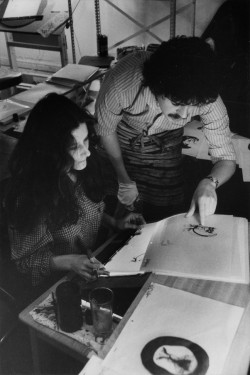 5
5 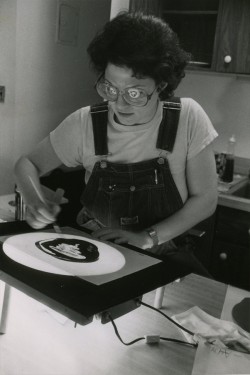 6
6
5. Steve Parton works with painter Barbara Samuels
6. Joey Epstein paints with fire in her eyes.
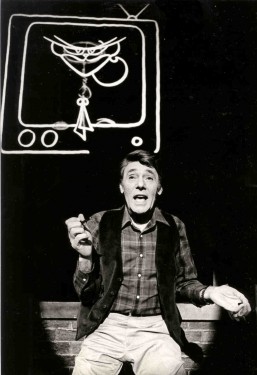 8
8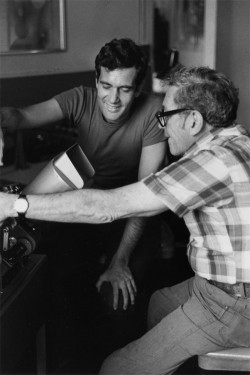 9
9
8. Harry Guardino on stage with the creation of “Tessie Kat” developing on screen behind him. This was Harry’s first big solo.
9. John Canemaker gets to see some of his animation with Sy Fried, editor.
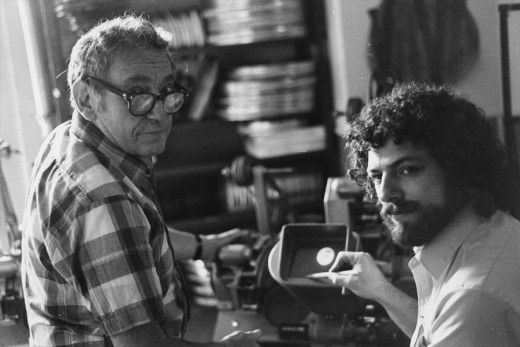
One of my quick stops from the lab on the way to Boston? No, I think this is a posed photo.
The success of the animation (including good reviews) posed a small problem for me. The rest of the show was ripped over the coals. When I started using some quotes about me in industrial ads, the producers came down on me for gloating over the others who’d gotten negative reviews.
All the same, it was a real learning experience in a big Broadway kinda way.
Animation Artifacts &Commentary &Independent Animation &John Canemaker &Layout & Design 08 Dec 2012 06:23 am
Elements, Chemistry and Odd Bits
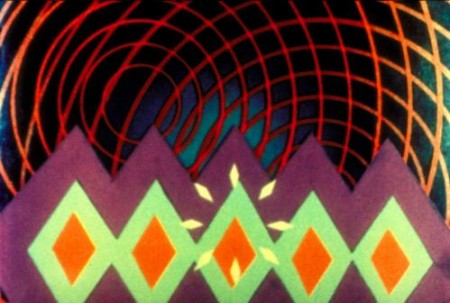
Oskar Fischinger, still from Allegretto, 1936-1943 © Center for Visual Music
- On Dec 16 in Amsterdam there will be a major exhibition of the work of Oskar Fischinger, a pioneer of animation film and abstract cinema. This opening will be an exhibition featuring various items including the films, the animation drawings, process material, the documents, correspondence, clippings, color charts, sketches, diagrams, patent drawings, and some of the sketches done (but not used) for Fantasia. Also exhibited will be notated graphic scores, material from the making of An Optical Poem, unshot animation drawings, and various other materials.
John Canemaker wrote about Fishinger for the New York Times, “Decades before computer graphics, before music videos, even before Fantasia (the 1940 version), there were the abstract animated films of Oskar Fischinger (1900-1967), master of “absolute” or nonobjective filmmaking. He was cinema’s Kandinsky, an animator who, beginning in the 1920′s in Germany, created exquisite “visual music” using geometric patterns and shapes choreographed tightly to classical music and jazz.’
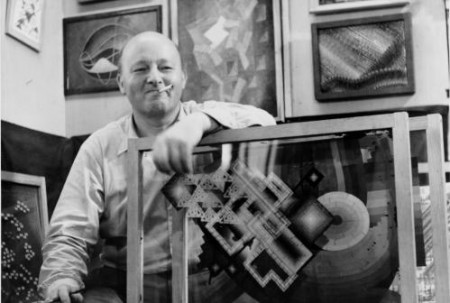
Oskar Fishinger in his Hollywood studio with panels from “Motion Painting”.
Consuming Sprits
This coming week, Wednesday Dec. 12th, Christopher Sullivan’s independent, animated feature will make its New York premiere with a week-long run at the Film Forum.
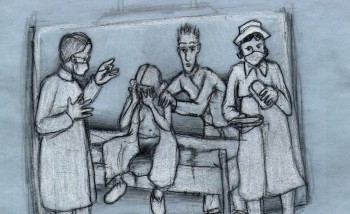 Described in the Film Forum’s press material: “The animation took 15 years of work… The characters were hand-drawn onto layers of glass which were then moved with needles and pins. The film seamlessly combines cutout animation, pencil drawing, collage, and stop-motion animation to create the haunting atmosphere of a self-contained world… (most of whose) characters walk shakily between self-medication and a bad trip… ugly characters (who) make up the most beautiful spectacle you’ve ever seen.â€
Described in the Film Forum’s press material: “The animation took 15 years of work… The characters were hand-drawn onto layers of glass which were then moved with needles and pins. The film seamlessly combines cutout animation, pencil drawing, collage, and stop-motion animation to create the haunting atmosphere of a self-contained world… (most of whose) characters walk shakily between self-medication and a bad trip… ugly characters (who) make up the most beautiful spectacle you’ve ever seen.â€
I’ve been looking forward to seeing this film for quite some time. Finally, I’ve been able to confirm arrangements to see it, and I will review it. I’m ready, given all the mediocre work I’ve seen lately.
Meet the film maker
Christopher Sullivan will be there IN PERSON! at the following screenings:
December 14 | 6:30pm
December 15 | 6:30pm
MoMA in Europe
This week, upcoming, the Museum of Modern Art will present a program of older European animation, and quite a few great classics will be screened in one very powerful program that will be shown three times. Trust me, if you don’t know these shorts, they are brilliant – all of them – and there is not one you should miss. Here’s a list of the films in the program:
Animation Abroad, 1946–59
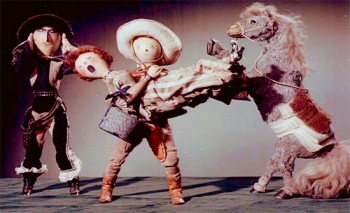 Arie Prerie (Song of the Prairie)
Arie Prerie (Song of the Prairie)
1948. Czechoslovakia. Directed by Jiri Trnka. 21 min.
A Litte Phantasy on a 19th Century Painting
1946. Canada. Directed by Norman McLaren. 3 min.
Fiddle-de-dee
1947. Canada. Directed by Norman McLaren. 4 min.
Charley’s March of Time
1948. Great Britain. 1948. Directed by John Halas and Joy Batchelor. 9 min.
A Phantasy
1952. Canada. Directed by Norman McLaren. 8 min.
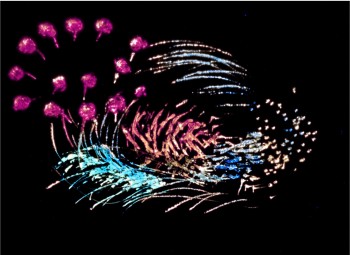 Blinkity Blank
Blinkity Blank
1955. Canada. Directed by Norman McLaren. 5 min.
Thumbelina
1955. Great Britain. Directed by Lotte Reiniger. 11 min.
Concerto for a Submachine Gun
1958. Yugoslavia. Directed by Dusan Vukotic. 13 min.
Les Astronautes
1959. France. Directed by Walerian Borowczyk with Chris Marker. 13 min.
Program 87 min.
Wednesday, December 12, 2012, 1:30 p.m., Theater 2, T2
Thursday, December 13, 2012, 1:30 p.m., Theater 2, T2
Friday, December 14, 2012, 1:30 p.m., Theater 2, T2
Nest week, and I’ll post the list next Saturday, there will be a number of Hollywood Cartoons that will be screened. Chuck Jones, Robert McKimson, Hanna & Barbera, Jack Hannah and Ward Kimball. They’re all represented.
Pups for Sale
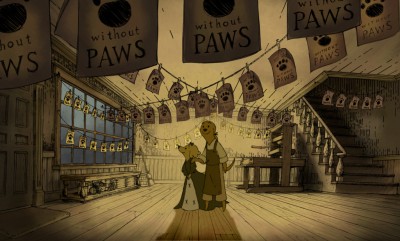 – As of yesterday, Friday, the Pups of Liberty became available for sale to teachers as well as the public, If you go to izzit.org or Amazon.com, you’ll see the assets that are available; indeed, they both link to an educational video, entitled The Pups of Liberty.
– As of yesterday, Friday, the Pups of Liberty became available for sale to teachers as well as the public, If you go to izzit.org or Amazon.com, you’ll see the assets that are available; indeed, they both link to an educational video, entitled The Pups of Liberty.
Perhaps you’ll remember the posts I published a while back on this short film produced by Bert and Jennifer Klein. I put those several articles together into one here to best showcase the story of this video. With the help of an all-star animation team (artists including: James Lopez (Hercules, Emperor’s New Groove, Flushed Away and Princess and the Frog), Eric Goldberg (Aladdin, Fantasia 2000, and Princess and the Frog), Barry Atkinson (Prince of Egypt, American Tail and The Lion King), and Mark Henn (The Little Mermaid, Beauty and the Beast, Aladdin, Muland and Princess and the Frog) Jennifer and Bert created this Revolutionary War-based film. It offered history as entertainment and allowed audiences to learn from a very entertaining series.
Now, the Kleins are not only making the video available for sale but have a new activities website which expands on that video.
This is a smart idea as Bert and Jennifer Klein seek to develop a new market and a new way to sell a creative product. If you’d like to learn more, take a look at these few clips of the animation. Here or here or here.
This Week’s Films
The schedule continues with our watching a lot of films on the run up to the Oscar nominations. By “us” I mean the people of the Academy, those who elect to see the films on a big screen before they vote. I’m sure a lot of members take the easy way out and watch DVDs of the current movies. I won’t hear this way out. As a matter of fact, they’ve asked us to accept the films via download. We’d watch the movies – the movies we’re voting for as Oscar contenders – via download over the internet. Sort of like NETFLIX. I still want to think of them as “movies”, I want the burden of going to a theater to watch them in a public place with other differing viewers, all inconvenienced at the same time. That is part of the experience, isn’t it?
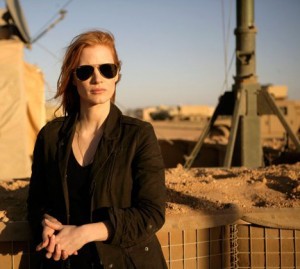 So, anyway, this week started off with Zero Dark Thirty. (I guess that’s supposed to mean 12:30 am – or half past midnight, in the dark.) On Tuesday the movie got the NYFilm Critic’s award for Best Film of the Year. I was hot to see the movie.
So, anyway, this week started off with Zero Dark Thirty. (I guess that’s supposed to mean 12:30 am – or half past midnight, in the dark.) On Tuesday the movie got the NYFilm Critic’s award for Best Film of the Year. I was hot to see the movie.
Turns out, to me, it was just one step above a TV movie version of the raid on Osama Bin Laden campsite to capture the guy. This film had no poetry in it and wasn’t about much other than the raid we watched. I didn’t like it. Dull. I did like Kateryn Bigelow’s last film, The Hurt Locker. But this film wasn’t that. I thought Jessica Chastain was miscast even though I am a big fan of hers. In fact there’s a Thursday luncheon where I’ll meet Ms. Bigelow and Ms. Chastain. I’m looking forward to that but have to lie if they ask what I thought of the film.
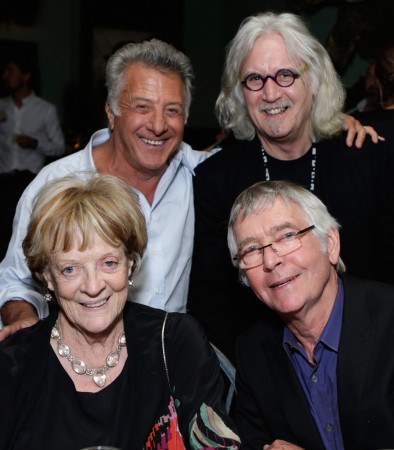
top – Dustin Hoffman, Bill Connolly
bot – Maggie Smith, Tom Courtney
On Wednesday, there was the fllm directed by Dustin Hoffman, The Quartet. This one was great. No miscasting here. Maggie Smith and Tom Courtney were brilliant. Billy Connolly couldn’t have been better, and it was easy to love Pauline Collins. She’s always great. The script by Ron Harwood from his own play was sparkling and always alive. The film was funny, warm, about people and always alive. Just great and human. Top drawer work. After the screening there was a penthouse cocktail party with a nice view, good free vodka or wine, and a chance to tell Dustin Hoffman and Billy Connolly about how good they were. Heidi told Mr. connolly how much she hliked his voice work in Brave, I just told him he was great, great, great. If I didn’t realize how stupid I sounded, I probably would have said a couple more “greats”. See this film for all the brilliant talent on display and the fun you’ll have watching it.
UPA
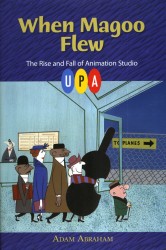 – Thursday night, I skipped the screening of Hyde Park to attend the lecture across town. Adam Abraham was speaking on the back of his book, When Magoo Flew: The Rise and Fall of Animation Studio UPA . The book was remarkable to me, and I was looking forward to meeting the author. At first there were very few people in attendance, but it soon filled up. I was happy to see friends, John Canemaker and Amid Amidi there.
– Thursday night, I skipped the screening of Hyde Park to attend the lecture across town. Adam Abraham was speaking on the back of his book, When Magoo Flew: The Rise and Fall of Animation Studio UPA . The book was remarkable to me, and I was looking forward to meeting the author. At first there were very few people in attendance, but it soon filled up. I was happy to see friends, John Canemaker and Amid Amidi there.
Adam’s talk was well done and ended with the screening of five films: Gerald McBoing Boing, Magoo Express, The Tell Tale Heart, Rooty Toot Toot and a rarely seen live action promotion for Magoo’s 1001 Arabian Nights, called: A Princess for Magoo.
I enjoyed the program and was pleased to meet Adam after the talk. Amid Amidi and I walked the few blocks to the subway and went home. A nice evening.
Back to the Routine
 – On Friday, I attended a luncheon for the film Argo. Ben Affleck, and several key people from the film attended and answered our questions about the movie while we ate at the Four Seasons Restaurant.
– On Friday, I attended a luncheon for the film Argo. Ben Affleck, and several key people from the film attended and answered our questions about the movie while we ate at the Four Seasons Restaurant.
The movie is promoted as some kind of recreation of actual events, and I’m sure it is. However, the film we see on the screen works just too well as a typical action-adventure sort of film, that it’s hard to accept its believability, regardless of how much is true. The climactic scene as the hostages are flying away from the Iranian police is just too Hollywood to be a reality, and Mr. Affleck admitted as much, making a joke of the idea. As an action film it works, but I wished for it to dig a little deeper.
A quick steak lunch and a return home. There was a screening of a documentary called West of Memphis which I was scheduled to attend last night, but I just didn’t feel up to it. So I stayed home. Enough movies for one week.
Articles on Animation &John Canemaker &Tissa David 27 Aug 2012 06:10 pm
Tissa – Her Animated Life
John Canemaker has an excellent article in the Tuesday edition of the Wall Street Journal. It can be found on line.
John Canemaker &Photos 26 Aug 2012 06:56 am
Bridgehampton Garden
- Last Sunday it seemed appropriate to post a past piece for the second time. Heidi and I had our second visit to John Canemaker and Joe Kennedy’s home outside of NY on Eastern Long Island. A comfortable respite from our workaday struggle in the tireless city. The chief overwhelming beauty of the home comes from the extraordinary garden Joe and John have built and cultivated. When we visited last year, it was June and everything was in the first blush of June. I could only compare it to my one visit to Giverny, Monet’s stunning gardens outside of Paris. I happened on to that country home at the perfect time when I visited years ago. The garden was as stunning as a . . . well, Monet painting.
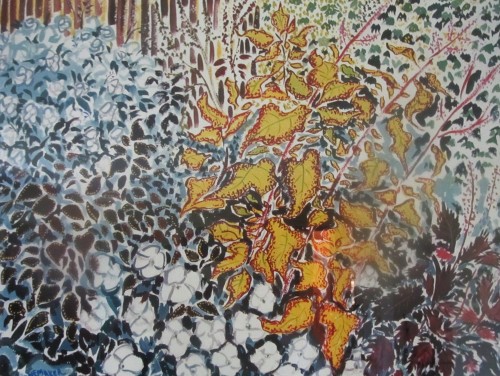
This is my favorite of John’s paintings. A big piece that hangs in the living room
over the mantel. I found myself staring at the delicate washes of colors from
across the room. The wash of color plays nicely against the complicated linear
detail of the flowers. It’s a well planned painting done with a spirited energy.
Last year, John and Joe’s garden was lush and blooming and beautiful. The house was full
of John’s beautiful paintings of the flowers. If I lived near such a garden, that would be what I’d be painting too. These paintings were some of John’s best work; the art here was at least equal to anything he’d done in animation. So on that post, last June, I showed a number of his paintings, too.
Last weekend, Heidi and I arrived with the forecast of rain, but it didn’t seem to come with us. The night was cloudy, but the weather was otherwise pleasant, and we had a delightful chicken dinner outdoors. The garden, in August, wasn’t the same. As Joe had explained the odd weather we’d been having this year – high temperatures, heavy rain in the Spring and drought in the Summer – forced all the flowers to bloom at the same time, and earlier than usual. Once the flowers closed, they remained closed and left the garden very green with the occasional flowering bush.
Saturday was full of rain. To be honest, I enjoyed it. The light to heavy rainfall felt very present and tactile. Things seemed more in deep focus. We went to a local museum and bought some used books at a great, local shop.
Finally, on Sunday we had very nice weather, but Heidi and I had to leave at lunchtime. It was a great break for us and gave us the chance to allow our blood to thin out a bit before heading back to the City.
I took a number of pictures which I expected to post last week, but found that I’d many more than I remembered. So today’s post will cover this year’s bloom.
 1
1While the rain came down Saturday morning,
I took a couple of photos outside our guest room door.
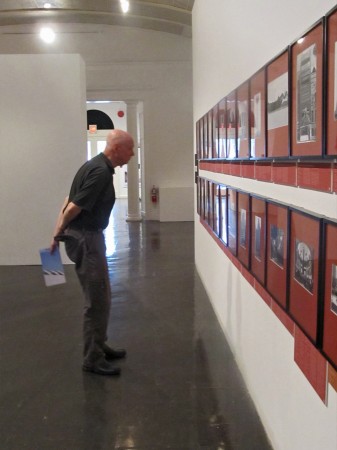 4
4
We decided to take a trip to a local museum which
was featuring a show of photographs of NY Landmarks.
(Oh the irony! We came to the Hamptons to look at photos of NYC.)
This is Joe looking at the photo wall.
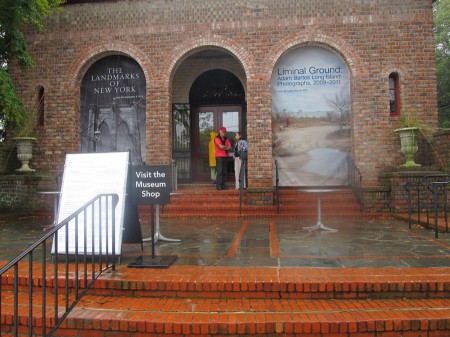 5
5
When we were ready to leave it was raining again.
Joe went to get the car so the three of us wouldn’t get wet.
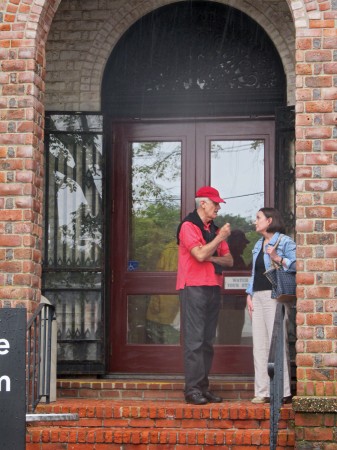 6
6
It was barely drizzling, so I went out into the rain
to get a couple of pictures of John & Heidi.
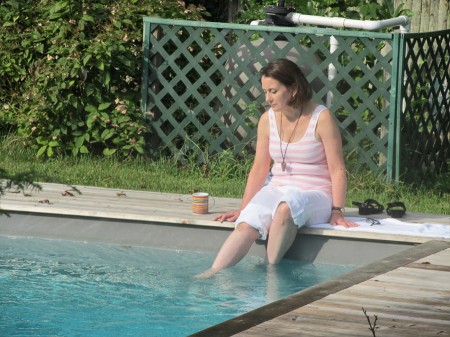 7
7
The rain took a short break.
Heidi went out to the pool.
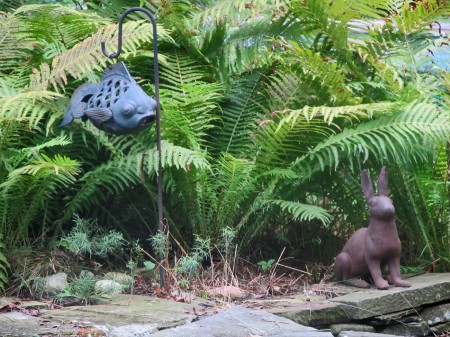 9
9
I couldn’t pass up a photo of the garden ornaments.
 10
10
There was the rabbit that Bill Tytla’s widow had given John
as a house gift. It came from Bill’s garden in Connecticut.
 11
11
For dinner John made his linguini in clam sauce.
Heidi and Joe participated in the kitchen.
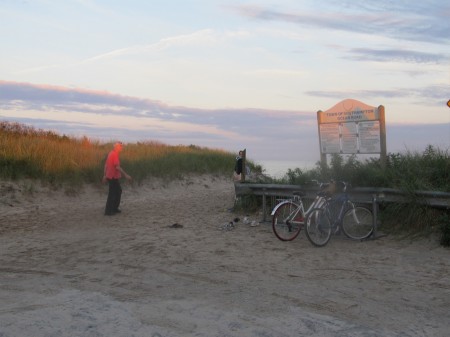 13
13
After dinner we took a ride to the beach.
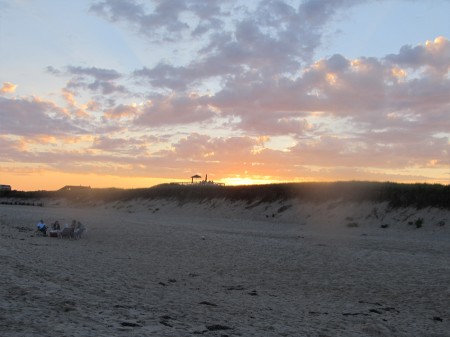 14
14
The sunset was beautiful at the end of the rainy day.
It’d be nice on the next day when we’d head home.
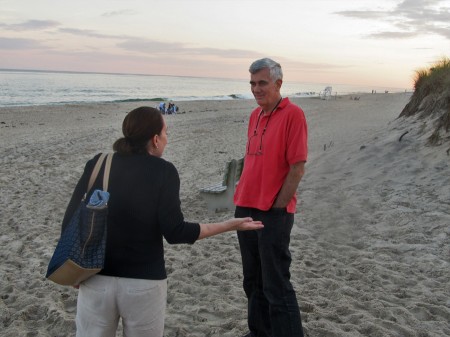 15
15
John and Heidi in discussion.
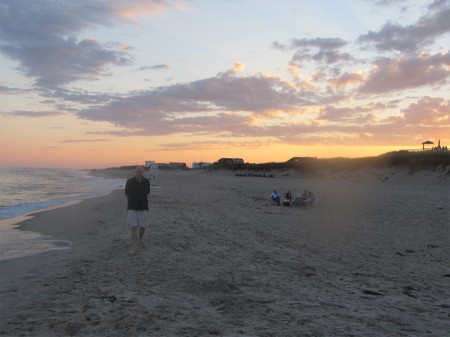 16
16
Joe in thought on the beach.
 20
20
It had turned into the perfect evening.
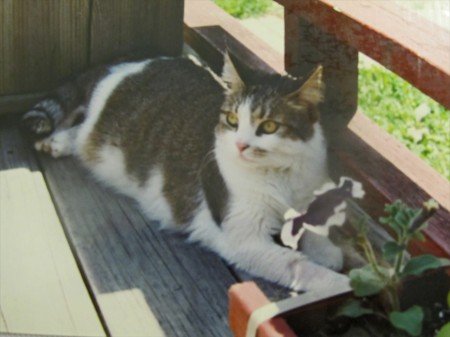 21
21
We heard about their cat, Lucy, who loved being outdoors
in their garden. Prior to coming out to this house, she had a
tough time getting over the death of another cat in the family.
The Bridgehampton house helped her.
Joe wrote a children’s book about her & John illustrated it:
Lucy Goes to the Country.
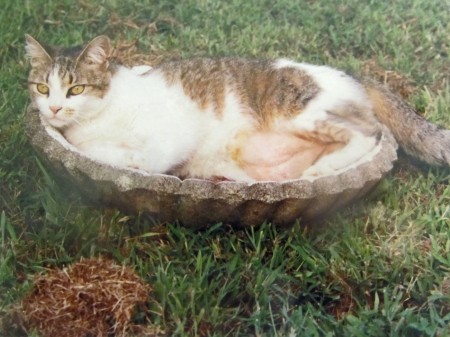 22
22
These are photos of photos they’d taken.
She found a birdbath that was about to be discarded, and
made it her own place to lie in the sun.
She had a difficult time leaving at the end of the weekend, and
John & Joe had a hard time finding her.
 23
23
I know how Lucy felt. When it was time for us to leave, I was
prepared to hide somewhere so I didn’t have to get back on the bus.
Animation &Animation Artifacts &Disney &Hubley &John Canemaker &repeated posts 20 Aug 2012 05:53 am
Fantasia FX – Schultheis – recap
John Canemaker recently completed his latest book about Herman Schultheis and the effects department at Disney’s during the early 40s. It, hopefully, will be published in late 2014. This encouraged me to pull up this piece I posted in Sept/2009. It’s amazing how much information I was able to cull from the photos I found on the DVD.
I’m pleased with this post and am glad to repeat it for those who might not have seen it. John’s book, by the way, is one I’m looking forward to reading. He’s written a bit about it on his website.
- Herman Schultheis was an effects animator who worked on Fantasia. He kept a tight record of the effects they were creating from 1938-1941 and a photo display of how they were done. Schultheis disappeared in 1954 while trekking through Central America, and the notebook was forgotten until his wife’s death in the early 1990s, after which it was discovered by Howard Lowery behind the couple’s bedroom wall.
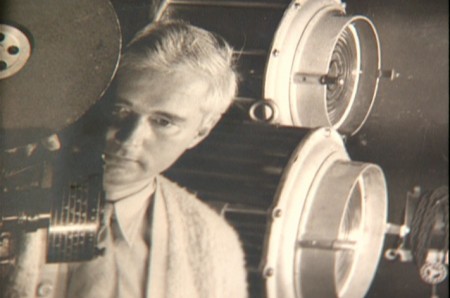
(Click any image to enlarge.)
Herman Schultheis created the book of charts and photos
which gives us a link to the many creative effects in the film.
The book is on display at the The Walt Disney Family Museum. It’s also been digitized so that visitors are able to go through the book, enlarge photos and view it page by page. An interactive display.
Prior to the discovery of the book we were able to figure out a few of the effects. One Disneyland show, in fact, recreated the bubbling lava scene from the Rite of Spring sequence.
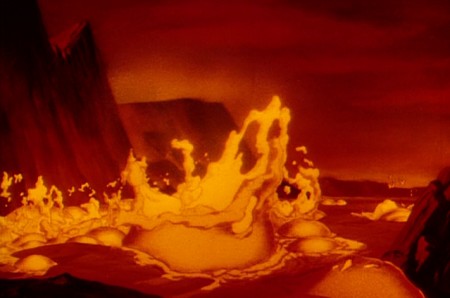
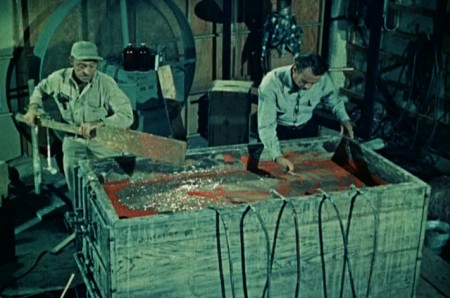
Josh Meador recreated the slow motion shoot of the
boiling concoction used to develop the bubbling lava.
However, the book revealed so much more than we’d understood
about how the superb effects had been crafted.
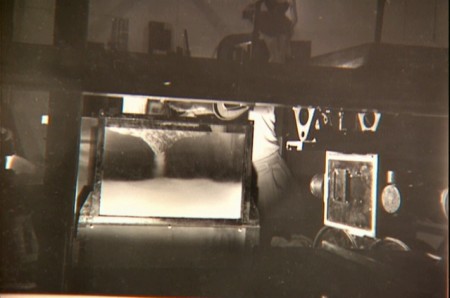
Using a vat of water, they were able to
drop ink into the liquid and film it in slow motion.
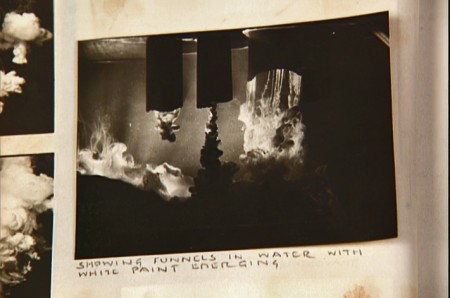
A photo of the ink spilling into the water behind built-in mattes.
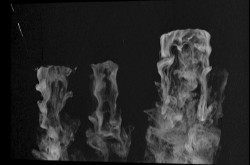
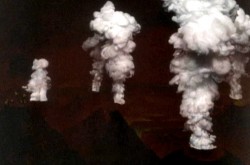
Taking the shot of the ink, they then turned it upside-down.
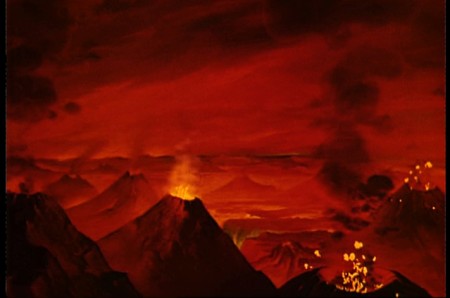
They then superimpose the “smoke” (or ink) over the volcanoes.
This same effect was used in Close Encounters of the Third Kind
to create clouds when the alien ships were moving in on the
farmhouse where the boy and mother lived.
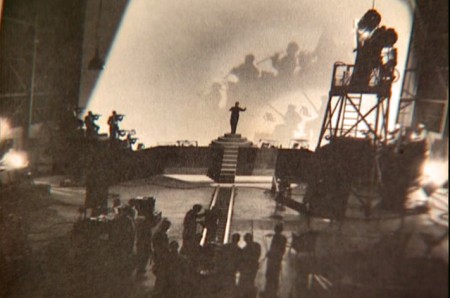
The orchestra was shot on a set with strong, planned shadows.
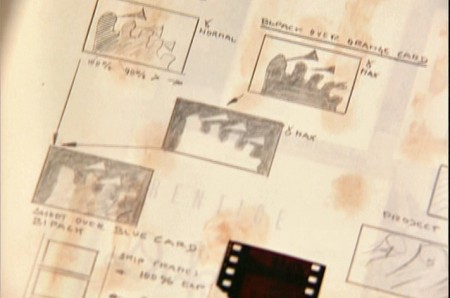
All these shots were orchestrated and planned for color effects.
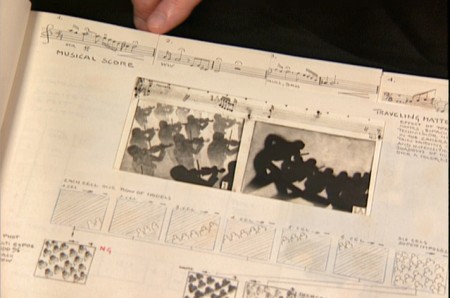
They were also catalogued by Schultheis who kept close
track of the music, as well, in his book. You can see a
page by page breakdown of the score at the top of the page.
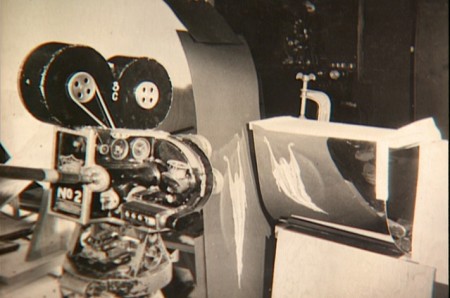
You can see the highly polished sheet of metal (middle left) which reflected
and distorted the animation drawings. This is what the camera photographed
in some of the scenes during the Night on Bald Mountain sequence.
It was also used for the fire in Bambi.
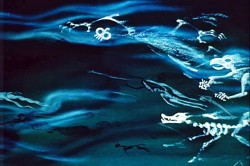 1
1 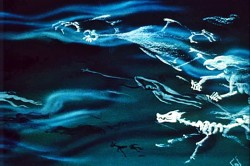 2
2
This scene’s ghosts were shot using that distorted metal reflection.
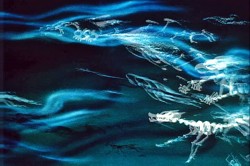 2a
2a 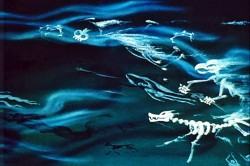 3
3
The ghosts also used a form of cross dissolve.
John Hubley explained to me how that was done, and
we used the technique in Everybody Rides the Carousel.
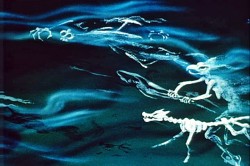 4
4 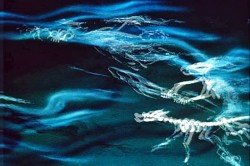 4a
4a
They shot the entire scene at 50% exposure. Then they went back
to the beginning and reshot the entire scene again at 50% exposure.
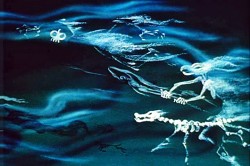 5
5 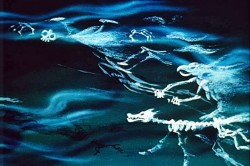 6
6
However on the second shoot, they started by shooting a black frame.
This made #1 fall where #2 should have been, #2 for #3 etc.
This creates a ghostly dissolve effect.
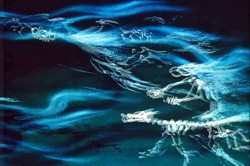 6a
6a 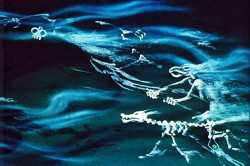 7
7
All of the drawings labelled with an “a” are the double exposures:
2a, 4a, 6a
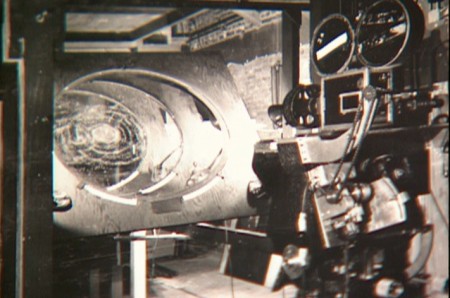
A make-shift circular multiplane camera was built.
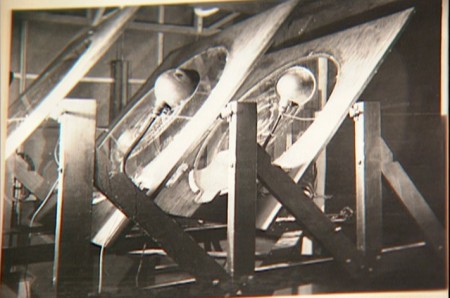
Created out of wooden sheets with holes cut out,
placed so they could shift angles, they were designed to
allow revolving artwork in the circular cut outs.
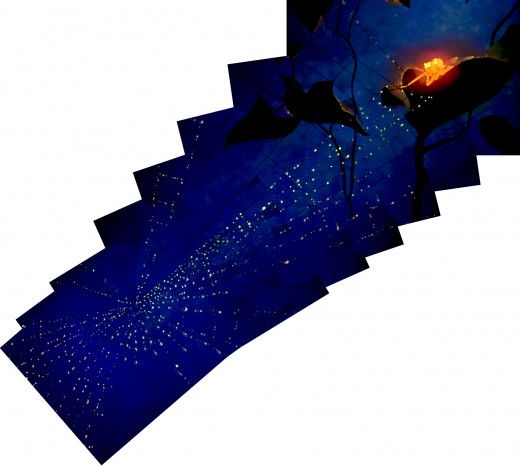
This allowed shooting scenes such as this shot of
a spider web as the camera moved around it
while dew glistened off of it.
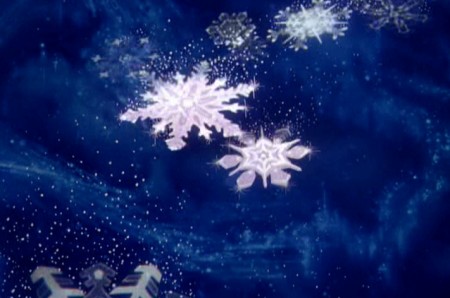
The spinning snowflakes are well explained in Schultheis’ book.
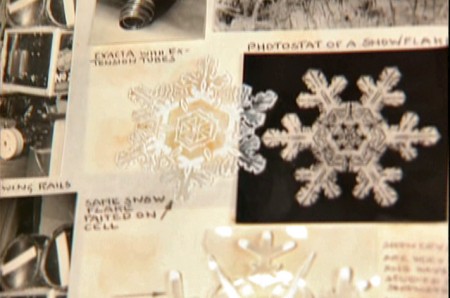
The snowflakes had a detailed construction.
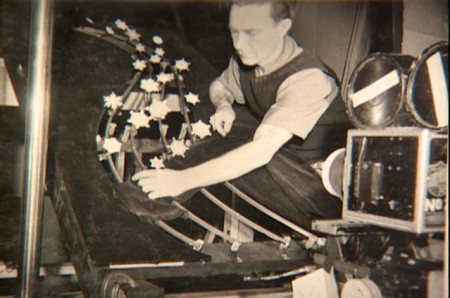
The path of action was intricately defined.
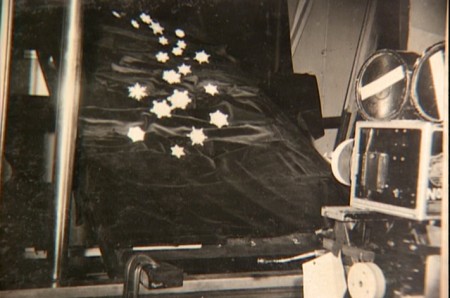
The snowflakes were shot against a sheet of
black velvet hiding the wire guides.
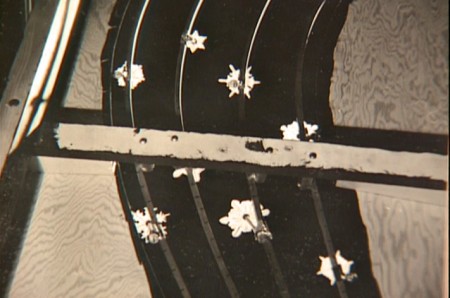
They were shot in tight closeup. From below you can
see the turning gears they were constructed on.
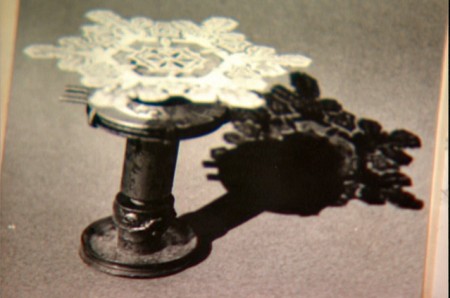
Each snowflake was built on a turning gear
so that they could revolve in their path of action.
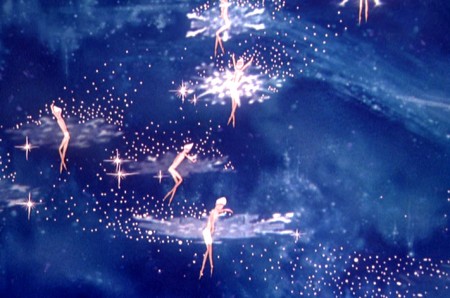
Burn these snowflakes over the multiplane background
and add matching 2D animated fairies within each snowflake,
and you have the finished scene.
John Canemaker &Photos &repeated posts 19 Aug 2012 07:00 am
John & Joe’s Garden
- Last year at about this time, Heidi and I went to visit John Canemaker and Joe Kennedy at their wonderful Bridgehampton house. That weekend I was so overwhelmed by the flush and beautiful gerden as well as the wonderful floral paintings John had done. I reported it on this blog, and was quite pleased with that post.
This weekend we’re repeating the excursion and have come to a different trip. For one, as Joe told me, the flowers bloomed much sooner this year, including those that usually bloom late, probably because of the peculiar weather we’ve been having. Consequently, the garden looked very different this year. It is now very green without much color.
This year we had more than overcast clouds affecting the weather. Rain stayed with us on much of Saturday. I didn’t mind very much, but there was little opportunity to walk through the garden with the ground so wet.
I’ve taken a few pictures this weekend and will add those later this afternoon once I get home, but for now I’m repeating last year’s post (with some minor changes).
- This past weekend, Heidi and I spent a lovely quiet time in Bridgehampton at the invitation of John Canemaker and his companion, Joe Kennedy. It made for a very restful and enjoyable time despite the grouchy weather.

The garden gives you the illusion that it’s larger than it is.
Even walking in it you feel that you could easily get lost in it.
The first dominant site you take with you as you visit the house is the amazing yard and the enormously colorful and tender care Joe and John have taken to cultivate their garden of a back yard. It’s stunningly beautiful. It feels almost as though these plants grew naturally next to each other and happen to take the shape it’s taken. The amount of weeding and nurturing and debugging is left completely behind as you bask in the warm glow of this garden with its variety of flower and shrub. It’s beautiful and peaceful and inviting. I couldn’t help myself over the course of the weekend; I took many walks in the area and sat and enjoyed it. I loved it.
The second thing that captivated me during the visit was a painting John had done. It sat on the wall of the guest room we stayed in. In the first few hours in the house I kept coming back to the painting. I liked it enough that I took out my camera and photographed it. As I did, I realized that there were other smaller paintings in the room, and I found them almost as lovely. There’s no doubt John has been taken with the amazing garden out back, and this has helped to color these fine watercolors.
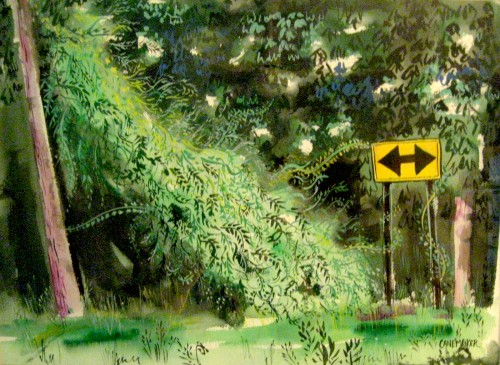
This painting obviously is not from the garden (given the road sign).
However, one can’t help but feel that the life in that garden spills over
into this painting – as it does in all the others.
At some point in the weekend, I asked John if he minded my photographing some of the paintings in the house and posting them on the blog. John, as always, was quite open to anything I wanted to do, so I went about quickly taking some photos. I also intended to mix in pictures from the garden. After all, I see these paintings and the flora as intermingling and working together in a lovely way.
There were some problems. The paintings lost some of their verve when photographed. The delicate colors were lost, and the shape of the pictures altered. (The lens of the camera seems to have slightly distorted the frames of the images.) I saw the pictures in some way influenced by Mary Blair’s work, but John took her colors and softened them. (The brashness of Blair’s work has always bothered me.) In the end, I found myself adjusting the pictures slightly to try to give them a bit of the feel of the originals, but I’m not sure I’ve succeeded. However, better you should get to see these images than none. My apologies to John.
So, I hope you enjoy the quick tour.


One of the larger paintings John had in his office, downstairs.

A beautiful flower that opened the day we arrived.

Heidi sitting on the porch just to the front of the garden.
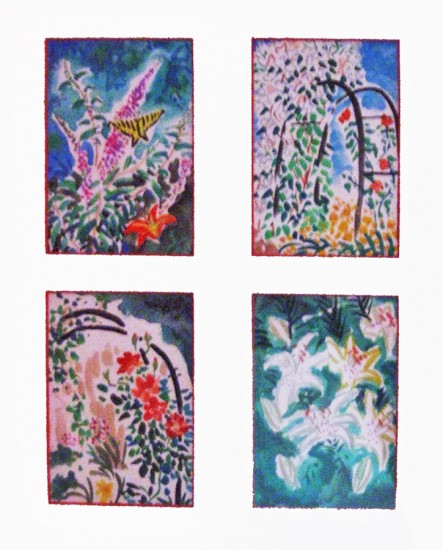
John has done many small quickly sketched watercolors.
Here, you can really feel the distortion of the camera’s lens.
Again, my apologies to John.
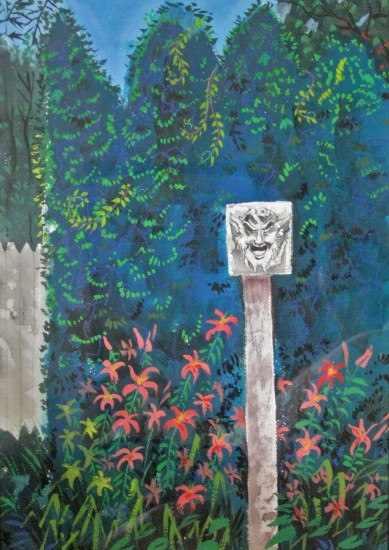
I had a hard time photographing this one.
The reflections in the picture frame’s glass was difficult to avoid.
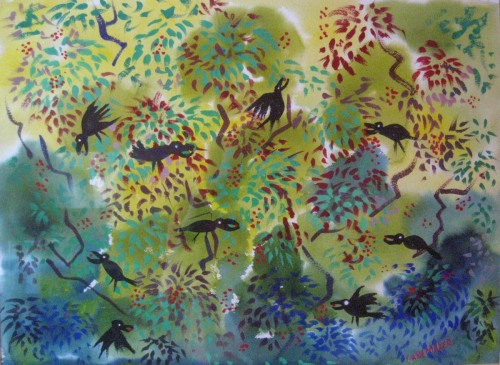
Another painting that just totally caught my attention.

Finally, a lovely little statue sitting just off the porch.
It’s a stone rabbit that once belonged to Bill Tytla.
Adrienne Tytla, Bill’s widow gave it to John as a gift.
Many thanks to John Canemaker and Joe Kennedy for a lovely weekend and all the wonderful inspiration, not only in the paintings but in the garden, as well. It was more than a small retreat.
Well, it’s later that afternoon, and we’re home. But I’m beat.
There are too many pictures I’ve taken and the post would be endless if I added them here, so I’ve decided to post a couple of pics of John’s paintings, and I’ll save the remainder for next Sunday. I’m sure you won’t mind. Though they are good pictures. See John, Joe and Heidi sharing a kitchen as they make linguine with clam sauce; see the four of us romping on the beach; see more pictures of the garden sculpture Bill Tytla’s widow gave John and Joe for their garden. And see some great pictures of the garden in the rain. I’m sure you’ll want to return next Sunday for that. (or not!)

Here’s John, Heidi and Joe outside their house.
It looks as though they’re greeting us, but in reality
Heidi and I are about to leave on Sunday afternoon.

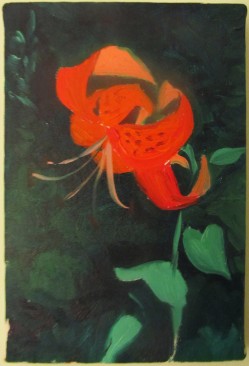
These two small paintings by John were
hanging in the guest bedroom we occupied.

This gem of a painting hung over the mantelpiece
in the living room. It belonged there.
Articles on Animation &John Canemaker &repeated posts &Tissa David 22 Jul 2012 04:46 am
Tissa – 1975
- The 1975 issue of Millimeter Magazine is an animation issue. There are a number of enormously informative articles. I was rereading a copy of the magazine, this past weekend, when I came across the Close Up section, wherein a couple of bios appear.
I’d like to show one for Tissa David that was included. I assumed John Canemaker authored the piece; there is no byline. When I asked him, he responded thus: “I wrote the article on Tissa. The quotes are from my first formal interview with her. It was for Millimeter when I was the animation editor and put together special animation issues.”
Tissa looks so young in that photo.
-
“I am a frustrated comedienne, for sure,” Tissa David will tell you, only if you ask. “I am a clown. If I weren’t shy, I’d probably be on the stage.” Instead she is an animator, one of the world’s best and busiest, and one of the few women to have reached the top in the traditionally male-dominated animated cartoon field.
She joyfully toils in her East-Side New York apartment, a warm, plant-filled place that often smells of baked apples. Classical music swirls quietly from a radio and the glow cast from the light under her animation board gives her the look of a sorceress.
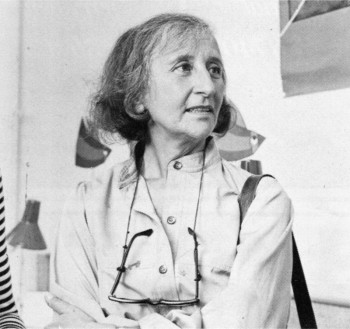 The lady has class—a fact one gathers upon first meeting, but a fact that is reaffirmed by catching a look at the creatures she is conjuring to life on her drawing board. The graphic line is strong and free, yet elegant (as is the artist); and when the drawings are flipped, the creatures move through their paces with a deliciously droll humor, a wit that is uniquely Tissa David’s.
The lady has class—a fact one gathers upon first meeting, but a fact that is reaffirmed by catching a look at the creatures she is conjuring to life on her drawing board. The graphic line is strong and free, yet elegant (as is the artist); and when the drawings are flipped, the creatures move through their paces with a deliciously droll humor, a wit that is uniquely Tissa David’s.
As a child in her native Hungary, Tissa saw Disney’s SNOW WHITE and thought (as so many others have thought after experiencing that film masterpiece), “Now this is something I want to do.” After graduating from art school, she became an assistant animator at Magyar Film Iroda in Budapest; a little more than a year later, in 1945, she was a co-owner of the Studio Mackassy and Trsi supervising all phases of production including story and camera and was sole animator of the puppet and cartoon films.
She left Hungary in 1950 during the height of the Stalin regime, and finally landed in Paris.
Jean Image Productions hired her in September 1951 and for two years she read sound tracks, planned layouts, animated, and did the entire editing of the feature-length, BONJOUR PARIS (1953). That studio closed and Tissa animated at La Comete next, a studio that had been Paul Grimault’s.
“I had absolutely no relatives outside of Hungary except in the United States. So I asked for a visa in 1950. It took at that time five years to get a visa, that was still the quota system. So I came to New York…I loved the U.P.A. cartoons. I decided I wanted to work in that studio.” In 1956, the United Productions of America’s New York Studio was the last tenant in a brownstone on Fifth Avenue and 53rd Street slated to be torn down for the construction of the 666 Tishman Building. There was a French girl in the UPA studio and so she introduced me,” Tissa recalls. “I had no sample reel. I went in once to make a sort of tryout. I was scared; I didn’t speak English, so I was just waiting, waiting, and Grim came by…Grim Natwick is the history of animation and I can rave about him. He created Betty Boop and animated the character of Snow White all the way through. UPA had an awful lot of work and they needed an assistant to Grim.”
At that initial meeting, Natwick boomed, “Now, you know what animation is!” Tissa quietly answered, “Animation is—animation.” Natwick laughed, “You can’t argue with that!” and thus began a professional partnership that lasted twelve years. “Isn’t it strange,” says Tissa today, “that SNOW WHITE got me into animation and I really learned my animation from Grim. I know a great deal about animation, I know I know, because even today I don’t do one line without something in my brain Grim told me.”
After UPA closed in 1958, Tissa and Grim freelanced as a team on countless TV commercials, and since Grim’s retirement, Tissa has soloed successfully and most notably on several John Hubley projects, i.s.: Of Demons and Men (1970), Eggs (1970), Children’s Television Workshop segments Cool Pool Fool, True Blue Sue, Truth Ruth and others, and Cockaboody (1973). Her latest animations include three CTW Letterman episodes, a scene in Shamus Culhane’s Noah’s Ark production, and over 110 feet of Hubley’s Bicentennial film, People, People, People. She has just completed some experimental animation fora Dick Williams project and is now starting, also for Hubley, a TV special based on Erik Erikson’s writings.
A description of Tissa David’s style of animation is difficult; for while it is a distillation of the Disney influence in timing, the UPA sense of humor-through-graphic-design, and the strong, poetic John Hubley mode, it also contains a different character, unique to Tissa David, that she calls the “female difference…If the same scene is animated by a man and by me, there will be a great difference, not in quality but in interpretation. John Hubley told me I have a fine sense for detail, not in the drawing itself because I make very loose drawings, but in a scene, in expressing feelings. I am a very intuitive animator—I never know when I sit down to work what will happen.”
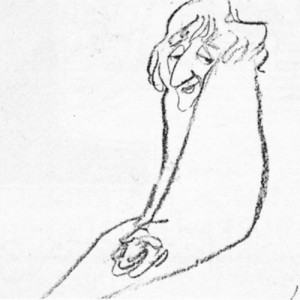 For all her gentleness, Tissa also contains an inner core of strength exhibited in her single-minded devotion to her art. Her opinions about that art, herself and other topics, is disarmingly to-the-point: “I believe very strongly that one must know how to draw,” she will offer on the subject of how-to-animate. “Even if you just animate objects, you must have a knowledge of drawing.” As for her struggles securing her place in animation, Tissa will admit, “…its very hard. Women can find work in animation if they have enough will to follow through and really do it. Even today, I’m always saying if I keep busy long enough, I will become a good animator.”
For all her gentleness, Tissa also contains an inner core of strength exhibited in her single-minded devotion to her art. Her opinions about that art, herself and other topics, is disarmingly to-the-point: “I believe very strongly that one must know how to draw,” she will offer on the subject of how-to-animate. “Even if you just animate objects, you must have a knowledge of drawing.” As for her struggles securing her place in animation, Tissa will admit, “…its very hard. Women can find work in animation if they have enough will to follow through and really do it. Even today, I’m always saying if I keep busy long enough, I will become a good animator.”
At the time this piece was written, Tissa was completing work on a pilot for Dick Williams’ film, Raggedy Ann & Andy; this one minute piece got Dick the film over Joe Oriolo and Shamus Culhane. She would thereafter work on John Hubley’s Doonsebury Special (just as he died mid film); and she was to animate for R.O.Blechman’s Simple Gifts.
Here’s a more recent photo of Tissa.
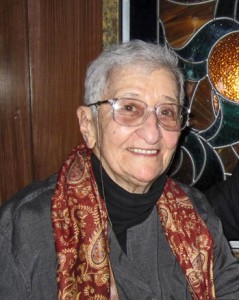
Tissa David was 91 last January.
Animation Artifacts &Disney &John Canemaker &Story & Storyboards 02 Jul 2012 04:43 am
Toot Bd – repost
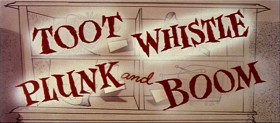 - Our Adventures in Music continue with the preliminary storyboard for what would ultimately become Toot Whistle Plunk & Boom. This is another board on loan from the archives of John Canemaker, and you can see the outgrowth from the prior film, Melody: Adventures in Music.
- Our Adventures in Music continue with the preliminary storyboard for what would ultimately become Toot Whistle Plunk & Boom. This is another board on loan from the archives of John Canemaker, and you can see the outgrowth from the prior film, Melody: Adventures in Music.
You can see how little of the magic was in this board, yet it obviously inspired others to keep it alive and make it work. Ward Kimball has to get most of the credit, though designs by Tom Oreb, Ken O’Connor, Eyvind Earle and Victor Haboush sure brought it to life.
The material I’m posting here is on large photostat copies. The problem is that the images are a bit fuzzy, and the text beneath the boards is illegible. In some cases, the appropriate text has been hand written on the copies themselves.
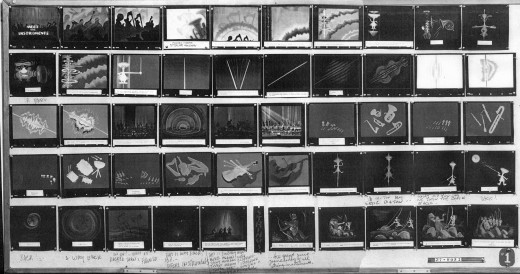 1
1
These are breakdowns of each row of the boards so that the images can be made as large as possible. Each row of images is split in two and labelled accordingly. #31a means Board 3 row 1 part a.
 11a
11a
 31a
31a
Ward Jenkins has posted some beautiful frame grabs from the completed film. Go here.
See this short on YouTube here.
John Canemaker deserves all the kudos he gets for lending this material to me as well as plenty more that he’s loaned this blog.
Books &Illustration &John Canemaker 15 May 2012 06:40 am
Les Passagers de la Grande Ourse
- Back in 2006, I posted a couple of pages of this book and, having found the film now on line, I thought it time for a new look at this Paul Grimault classic from 1942.
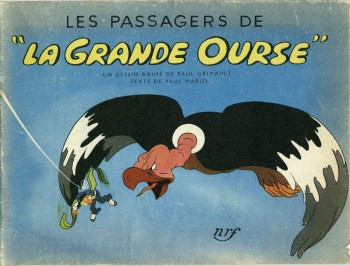 – In 1942 Paul Grimault released an animated film entitled Les Passagers De “La Grande Ourse.” The film had actually been completed in 1939 and titled The Passengers of the Great Bear, but because of the outbreak of WWII the film suffered setbacks and was released in 1942 with the new title.
– In 1942 Paul Grimault released an animated film entitled Les Passagers De “La Grande Ourse.” The film had actually been completed in 1939 and titled The Passengers of the Great Bear, but because of the outbreak of WWII the film suffered setbacks and was released in 1942 with the new title.
Several years ago, John Canemaker gave me a gem of an attractive little book that was illustrated with images from the film. Grimault was the father of French animation, and I’d always assumed that this film was a feature. In fact, it was a nine minute short, but it was important historically because it was the first big French animated production trying to out-Disney Disney.
The story is very unlike American films. There’s a fanciful sense of imagination that is true of many French cartoons. In summation the story is:
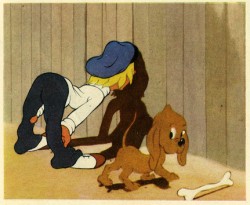 A little boy and his dog sneak into a shipyard and are grabbed by a crane which places them on a ship in dock, loading. This ship, “The Grand Ourse,†is an oddity in that it is fitted like a zeppelin with balloons to lift it into the air.
A little boy and his dog sneak into a shipyard and are grabbed by a crane which places them on a ship in dock, loading. This ship, “The Grand Ourse,†is an oddity in that it is fitted like a zeppelin with balloons to lift it into the air.
Boy and dog arrive in their compartment, accidentally, as the vessel starts to take-off into the sky. Adventures ensue with the boy and dog confronted by a restive eagle and a deaf and dumb robot
Here are some of the pages of the book:
A carbon copy of the credits for the film was enclosed within the book when I received it.
It was copied onto one of those pieces of paper that could only be European, sort of a tissue that seemed delicate.
That’s attached to the left.
This past week I found a nice copy of the film posted on YouTube. You can watch it.below, and see how it compares to the published book.
Les Passagers de la Grande Ourse (Paul Grimault – 1941)
